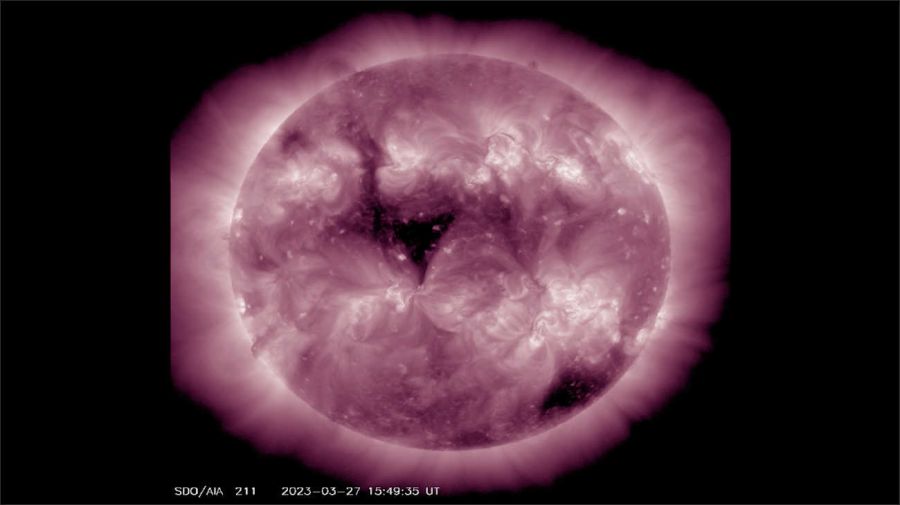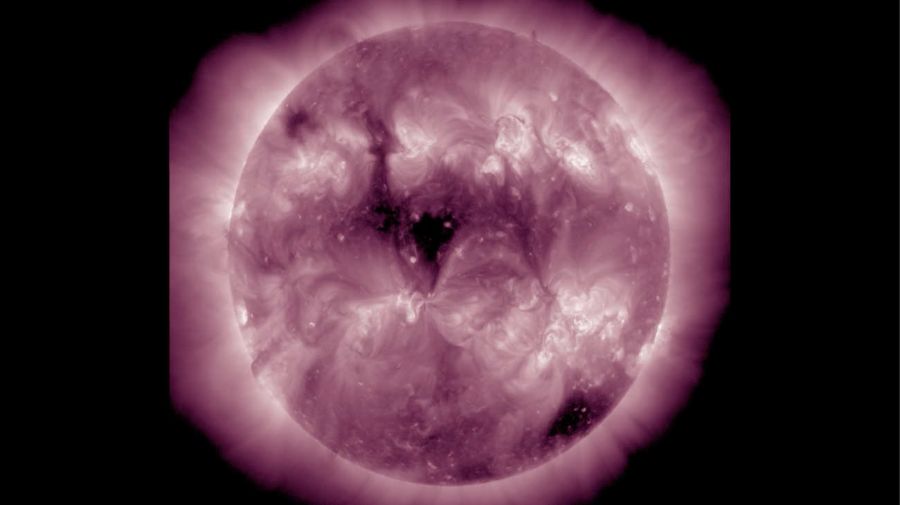A huge hole in the Sun’s surface could wreak havoc on Earth in the coming days, though the chances of a catastrophic disturbance are low, scientists say. It’s about a coronal hole, which has already unleashed solar winds of almost 3 million kilometers per hour towards our planet and that, according to the US space agency, will impact our planet on Friday.
NASA’s Solar Dynamics Observatory released a photo showing a triangular-shaped dark gap on the sun’s surface that is 20 times larger than Earth. This is an area of open magnetic field from where the high-speed solar wind rushes into space.
Although on Earth they can cause beautiful natural light shows in the sky, the so-called auroras, solar winds can also disrupt satellites in space, power grids, and GPS navigation systems.
NASA discovered a new coronal hole in the Sun, which could generate geomagnetic storms
The new coronal hole is the second recently detected. The previous one, about 30 times the size of Earth, was found on March 23 and released solar winds that triggered impressive auroras in the Northern Hemisphere.
“Gaseous material flows from a relatively small hole in the sun’s atmosphere, now in front of our planet”is explained on the site specialized in astronomy SpaceWeather.com. “Arctic auroras are likely when the solar wind arrives.”
What are the coronal holes of the Sun and why are they a concern?
Coronal holes are regions of open magnetic fields that appear as dark areas in the corona., the outermost part of the sun’s atmosphere. They appear as dark spaces in images and are characterized by lower temperatures and densities than the surrounding parts of the corona.
Coronal holes, some of which are so large that they take up about a quarter of the sun’s surface, were discovered by NASA’s Skylab in the early 1970s, but scientists still aren’t entirely sure why they occurred. generate.
An ‘alien mothership’ could be sending probes to Earth, say scientists
The solar wind leaves the sun with special force through the coronal holes., because they increase the output of particles, mostly protons and electrons. Generally, magnetic field lines on the sun’s surface form coronal loops (bright, curved strands of plasma) that keep gases contained.
However, in coronal holes, these magnetic field lines do not close in on themselves, but stick directly to space, leaving an open channel through which the solar wind can fly unobstructed.
A solar wind typically leaves the sun at speeds of about 1,400,000 kilometers per hour, but the solar wind exiting the center of a coronal hole travels much faster, up to 300 million kilometers per hour.

When these solar wind particles reach Earth the result can be “geomagnetic storms“, a temporary disturbance of the magnetosphere. This is the area around Earth controlled by our planet’s magnetic field and protects it from harmful energy from space.
“Earth’s magnetic field shields us from the solar wind, and material from the solar wind never reaches the ground,” explained Professor Mathew Owens of the Department of Meteorology at the University of Reading (UK).
And I add: “But the solar wind can crush and deform Earth’s magnetic field, and this can have a number of effects.. Every time a magnetic field changes, that drives electrical current flowing up into the upper atmosphere.”
NASA detects a mysterious anomaly in Earth’s magnetic field
Geomagnetic storms can penetrate our atmosphere, threatening spacecraft and astronauts, disrupting navigation systems, and wreaking havoc on power grids.
“The damage to the satellites is caused mainly by energetic particles that modify or even destroy the electronic elements on board the satellites”according to Daniel Verscharen of the Department of Space and Climate Physics at University College London.
“The lasting input of energy from a fast solar wind stream into the magnetosphere, which may come from this coronal hole, may lead to an enhancement in Earth’s radiation belts,” he explained. “This means that satellites orbiting through the radiation belts can be affected by energetic particles from the enhanced radiation belts.”

Disturbances in the magnetosphere can also trigger an aurora, the natural light show normally seen near the poles.
Verscharen said, however, that a fast solar wind, of the type emitted by the new coronal hole, will not be enough to cause a large geomagnetic storm: “I wouldn’t expect a large geomagnetic storm from this coronal hole.”
Owens, for his part, also believes that there will not be much damage, although there could be a problem with the GPS systems during the weekend of April 1 and 2. “Rapid streams of solar wind, coming from coronal holes, create moderate space weather,” he said.
They discovered in an asteroid organic elements essential for the beginning of life on Earth
“But the biggest storms come from coronal mass ejections, huge eruptions of solar material, and I don’t think Earth will be in the line of fire for one of them in the next few days,” he simplified.
In 1859, a massive geomagnetic superstorm known as the Carrington event sent powerful coronal mass ejections (CMEs) toward Earth, disrupting communications on the ground. If such an event were to occur today, the effects would be catastrophic on our communications systems.
According to astrophysicists, the probability of a solar storm capable of causing a catastrophic disturbance occurring in the next 10 years is 1.6 to 12 percent.
ds
You may also like
